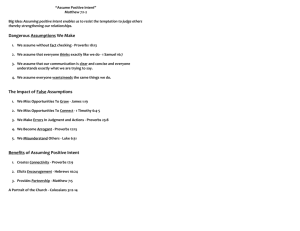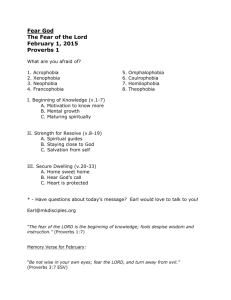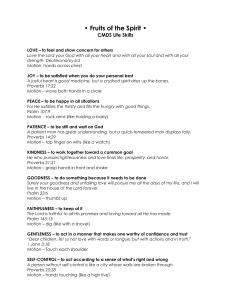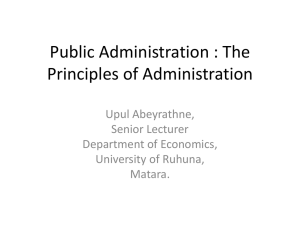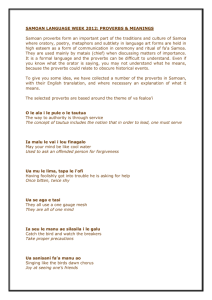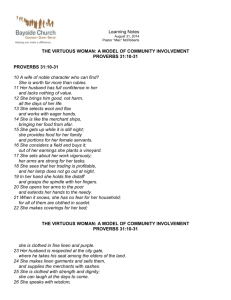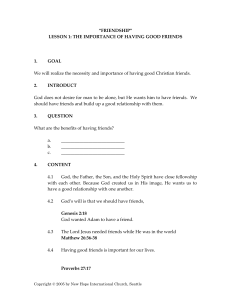An Overview of English and Vietnamese Proverbs A
advertisement
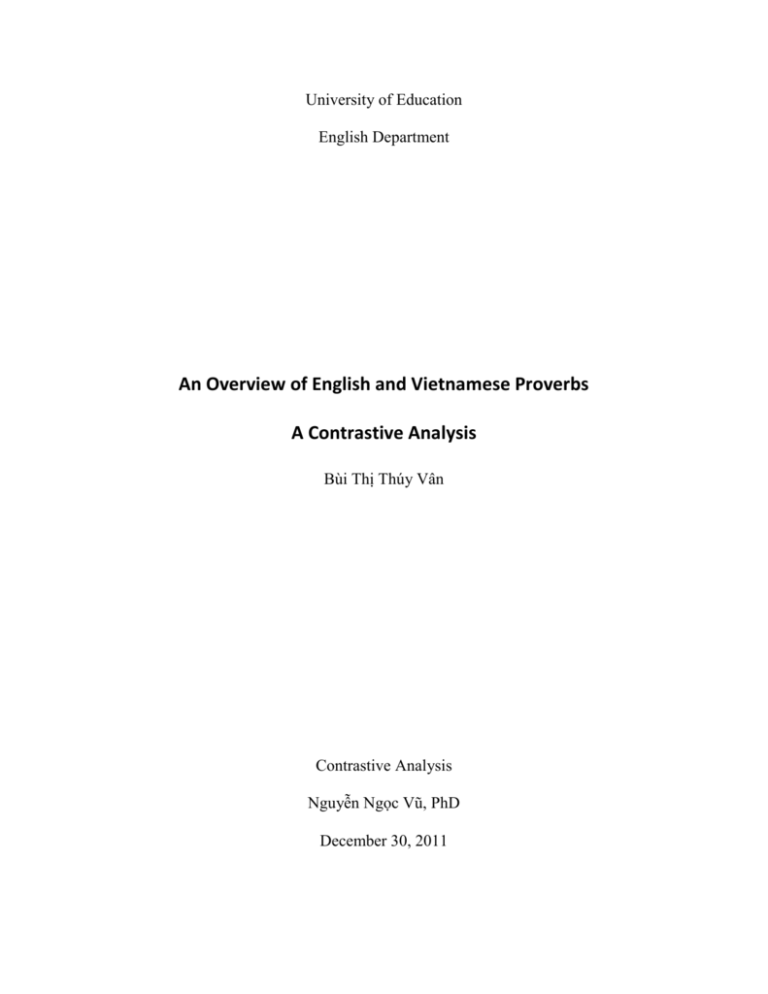
University of Education English Department An Overview of English and Vietnamese Proverbs A Contrastive Analysis Bùi Thị Thúy Vân Contrastive Analysis Nguyễn Ngọc Vũ, PhD December 30, 2011 Abstract Human language, indeed, is a product of society and culture. It reflects social life and culture and vice versa these aspects shape language’s variety in formulae, function to meet the human’s communicative demand. Of all verbal genres of language, the folklore genres (i.e., folksongs, fairy tales, legends, allegories..) appear to carry social and cultural reflection the most. And among those various folklore genres above, proverbs are the most concise form of wisdom. They contain everyday experiences and common observations in short and compendious language as effective and rhetoric expression for spoken and written communication. With their multi-function in communication and variety in formation, proverbs have been used, collected and studied for generations as informative linguistic signs of one culture. Using proverbs in your utterances or articles makes them sound far more not only native-like, natural but also vivid and effective. However, proverbs, as a concise form of cultural wisdom, are not just understandable from its individual elements’ literal meaning. Each language, English or Vietnamese has a long history and large quantity of proverbs that are closely connected with their distinguish cultures and reveal their special national characteristics. This paper investigates some resemblances, differences as well as some gaps between proverbs in two languages: English and Vietnamese via explanations and examples. Definition of English and Vietnamese proverbs Proverbs are popularly defined as simple and concrete expressions of popular wisdom which are widely known and repeated in certain culture or community. This wisdom is in the form of observations that based on common sense or practical experience of humanity. Proverbs can be seen as a bit of advice or simply an attitude toward a situation. Many efforts were made to reach an academic definition. However, it seems that they have not led to a more precise one. You can find in Cambridge advanced learner’s dictionary (2005) a brief definition of proverbs as “A short sentence, usually known by many people, stating something commonly experienced or giving advice”.(p.1017). Also , Wolfgang Mieder defines a proverb as “a short, generally known sentence of the folk which contains wisdom, truth, morals, and traditional views in a metaphorical, fixed and memorizable form and which is handed down from generation to generation.” Take the old proverb “nothing ventured, nothing gained” for examples. This complete sentence contains a basic truth: If you don’t make efforts, invest time and money or even take risk for something, it’s not likely that you can achieve it. Success comes to one who dares. This truth is recorded and proved by generation’s observation and practical verification and continuingly passed on as a proverb . A similar definition of Vietnamese proverbs is posted on wikiquote .org, an online encyclopedia. They noted that “Vietnamese proverbs are concise statements expressing deep thoughts, practical knowledge, and experience-based judgments, covering all aspects of Vietnamese life, and bearing some flavor of a particular culture.” Nguyen Dinh Hung (2007) also defined proverbs in his book “Tục ngữ là một câu nói hoàn chỉnh, diễn đạt trọn vẹn một ý mang nội dung nhận xét quan hệ xã hội, truyền đạt kinh nghiệm sống, cho bài học luân lý hay phê phán sự việc.”(“Tuyển tập thành ngữ, tục ngữ, ca dao Việt-Anh thông dụng”, p.10). “Cha nào, con nấy” is an ancient typical Vietnamese proverb carrying the message about the family inherited resemblances. Children in a family must inherit some characteristics from their parents and we can look at a child to know something about its family or vice versa, at parents to image their children. Coincides in features and expressions of English and Vietnamese proverbs As an language genre that exists in almost every language, proverbs from all countries, including English and Vietnamese, share some common features in markers and meanings that can be briefly mentioned below. One of the most acknowledged but controversy features of proverbs is traditional one. Proverbs, as mentioned above, are collected and passed on through generations. It’s no doubt that proverb definitions often include the term of traditionality. However, it isn’t easy to decide whether a statement is traditional at all. How long does the statement exist enough to be traditional? As Meider raised in his book Proverb: A handbook the case of proverb-like sentence “Where there were star, there were scandals.” and himself refused its proverbiality. He also demonstrated that this created wisdom may sound like a proverb but need to be used over a period of time by others to be a real proverb. In Vietnam, the recently published book Sát thủ đầu mưng mủ can also provide us some examples for the issue. The book lists many new ironic or for-fun sayings from the youth , including anti-proverb sentence (“ Cả con ngựa đau cả tàu không ăn cỏ”, “Ăn trong nồi ngồi trong xó” ), anti-idiom one(“đen như con mèo hen”), idiom-like one (“chán như con gián”, “bực như con mực”) and even some new proverb-like sayings (“đời rất dở nhưng vẫn phải niềm nở”, “sống đơn giản cho đời thanh thản”). These new proverb-like does give some meanings, viewpoints or experiences but listed in the book, they are only ironic sayings. It requires longterm recognition and usage to make these idioms or proverbs. Other features of proverbs are much clearer. They’re all about formulaic formation of proverbs. Proverbs in both languages are short and concise, contain only two ,three words(“ time flies”, “tham thì thâm”) to the average of seven. Speaking of structural matters, how can we make too many proverbial texts with just a few words? Several paremiologists, including Meider (2004, p.6), have claimed that proverbs can be reduced to some certain typical moderns. Some of them are “Better X than Y, “Like X, like Y”, “One X doesn’t make a Y”, “If X, than Y” in English such as “Better poor with honor than rich with shame”, “Like father, like son”, “One robin doesn’t make a spring”, “if at first you don’t succeed, than try,try again”. These typical patterns are easily found in Vietnamese proverbs like “Chết vinh hơn sống nhục”, “Cha nào , con nấy”, “Một cây làm chẳng nên non..”, “Có chí thì nên”. These short patterns are beautified with certain stylistic features that are summarized in Shirley Arora’s seminal article on “The Perception of Proverbiality” (1984) and repeated in Meider’s work (2004). Those features are clearly demonstrated by proverbs in both English and Vietnamese, including alliteration(“Forgive and forget”, “Tham thì thâm”), parallelism(“Easy come, easy go”, “Đói cho sạch, rách cho thơm”), rhyme(“A little pot is soon hot”, “Một giọt máu đào hơn ao nước lã”) and ellipsis (“Once bitten, two shy”, “Có chí, thì nên”). Besides, rhetorical effectiveness are also added to proverbs through some internal features such as hyperbole (“All is fair in love and war”, “Tấc đất, tấc vàng”), paradox (“The nearer the church, the farther from God”, “Thất bại là mẹ thành công”) and personification (“Hunger is the best cook”, “Cái chết đánh chết cái đẹp”).Metaphor, employed in a figurative or indirect way, also play a big role in this task (“A watched pot never boils”, “Cái kim trong bọc cũng có ngày lòi ra”) although not all proverbs contain metaphor. In addition to those universal features, proverbs in English and Vietnamese still share one more feature: idiom inclusion. Hung (2007) wrote in his book that English and Vietnamese proverbs can both contain an idiom. He also took out some examples in English such as “Don’t put all your eggs in one basket” ,including “put all one’s eggs in one basket”; “Birds of a feather flock together” with the presence of the idiom “Birds of a feather” and in Vietnamese “Cháy nhà hàng xóm, bình chân như vại” with the idiom “bình chân như vại”. Bypassing all those linguistic formation, it is proverbs’ images and meanings that count. Although English and Vietnamese proverbs come from two quiet different cultures, western and eastern ones, they somehow capture similar daily observations and experiences. There are some proverbs that are even expressed with same images despite their different origins, the cultures, lifestyles and ways of thinking they come from. Although there’s not a large number of them, we can take the proverbs “Easy come, easy goes” and ” Dễ được, dễ mất” in two languages as examples. They both bring the message that something like money or materials you gain easily without efforts tend to get spent or consumed in a easy way as it comes. Some other proverbs with similar images and meanings in English and Vietnamese can be listed such as: A friend in need is a friend indeed. Lúc họoạn nạn mới biết bạn bè Great minds think alike Chí lớn thường gặp nhau Blood is much thicker than water. Một giọt máu đào hơn ao nước lã. Laughter is the best medicine Một nụ cười bằng mười thang thuốc bổ Speech is silver, silence is golden Lời nói là bạc, im lặng là vàng United we stand, divided we fall Đoàn kết thì sống, chia rẽ thì chết. Grasp all, lose all. Tham thì thâm Other times, other ways Mỗi thời, mỗi cách Easier said than done Nói dễ , Khó làm The empty vessel makes greatest sound. Thùng rỗng kêu to Love is Blind Tình yêu là mù quáng Better die with honor than live with shame Chết vinh còn hơn sống nhục Don 't trouble troubles till trouble troubles you Sinh sự, sự sinh His eyes are bigger than his belly No bụng đói con mắt Like father, like son Cha nào, con nấy Silence gives consent Im lặng tức là đồng ý So many men, so many minds Chín người, mười ý The more, the merrier Càng đông càng vui There is no smoke without fire Không có lửa sao có khói One good turn deserves another Ở hiền gặp lành Differences in English and Vietnamese proverbs As mentioned before, proverbs are wisdom collections that reflect cultures so they are marked with assertive cultural characteristics. English and Vietnamese proverbs draw some obvious differences in illustrative devices and meanings, which reflect profound affection of different cultures, economics, religions and regimes. The same meanings are conveyed by alternative images and same images don’t necessarily arouse similar messages. It’s easy to see that most of the English and Vietnamese proverbs fall into this category of comparison. Those which bring coincide meanings conveyed by different images can be illustrated with the example of this couple of proverbs: “Mưu sự tại nhân, thành sự tại thiên” in Vietnamese and “Man proposes, God disposes” in English. Both proverbs give an explanation for the smoothness or roughness in the process of doing something. Humans can make detailed plans and do their bests to achieve something but finally, that success or failure we get is decided by an ultimate power. In English, almost people are Protestants or Catholics so they consider Jesus, as a representative of superpower and mention Jesus in this proverb as God. In contrast, Vietnamese people have long hold beliefs in their ancestors then adopted Buddhism, Christianity and other religions later. To the majority, the supreme power is not Jesus or Buddha but an power over the sky name “ông trời”. As the result, “trời” is mentioned in this Vietnamese proverbs and “God” in English one. One meaning is manifested in two images, reflecting different religious beliefs. A large number of viewpoints and experiences that are shared by English and Vietnamese people but showed in alternative imagery devices can be found as listed below: Out of sight, out of mind Xa mặt cách lòng Birds of the same feather stick together Ngưu tầm ngưu, mã tầm mã A thief knows a thief as a wolf knows a wolf Suy bụng ta ra bụng người When the blood sheds, the heart aches Máu chảy, ruột mềm Travelling forms a young man Đi một ngày đàng, học một sàng khôn A picture worths a thousand words Tai nghe không bằng mắt thấy Practice makes perfect Có công mài sắt có ngày nên kim There's a will, there's a way Có chí, thì nên Judge not, that you be not judged Dĩ hoà vi quý Pay a man back in the same coin Đi với bụt mặc áo cà sa, đi với ma mặc áo giấy No pains, no gains Tay làm hàm nhai Necessity knows no laws Túng thế phải tùng quyền Ill-gotten, ill-spent Cuả thiên, trả địa While there's life, there's hope Còn nước, còn tát Do not judge the book by its cover Đừng xét đoán người qua bề ngoài Losers are always in the wrong Thắng là vua, thua là giặc What goes around comes around Gieo nhân nào, Gặt quả đó For mad words, deaf ears Tránh voi chẳng xấu mặt nào Half the world not know how the other half lives Đèn nhà ai nấy sang If you cannot bite, never show your teeth Miệng hùm, gan sứa Tit For Tat An Eye For An Eye A Tooth For A Tooth Ăn miếng trả miếng Neck or nothing Không vào hang cọp sao bắt được cọp con One drop of poison infects the whole of wine Con sâu làm sầu nồi canh So much to do, so little get done Lực bất, tòng tâm All dogs have his days Ai giàu ba họ, ai khó ba đời There is also a case when only one proverb of English can cover the meaning of the addition of two proverbs of Vietnamese and vice versa. We need both Vietnamese proverbs “Ăn có chừng, chơi có độ” and “Tửu bất khả ép” to convey the whole meaning of an English proverb “Eat at pleasure, drink with measure”. Moreover, the English proverb “Each bird loves to hear himself sing” just express a half meaning of “Văn mình, vợ người” Vietnamese proverb. Proverb Gap Different cultures, societies, religions lead to not only differences in proverbs but also some proverb gaps, some unique topics that rarely exists in another language. In this case of English and Vietnamese, Hung (2004) noted in his book Tuyển tập thành ngữ, tục ngữ, ca dao Việt-Anh thông dụng (p.14-15) that proverbs of experiences on agricultural production, weather, nature place a remarkable part of proverbs, sketching a portrait of a wet-rice-cultivation culture such as “Tốt giống, tốt má, tốt mạ, tốt lúa”, “Một lượt tát, một bát cơm”, “Đầu năm sương muối, cuối năm gió nồm” or “Muốn giàu mua trâu cái, muốn lụi bại nuôi bồ câu” ,etc while we find none of those equivalences or even proverbs in common topic in English. Struggling and fighting is also a distinguish topic in English and Vietnamese proverbs. In Vietnamese one, with the thousand-year history under domination and oppression of other countries, the topic of struggle and fighting against dominant class and invaders for existence and independence is fiercely attested with bitter and subtle images. Proverbs of this topic also keep a remarkable number in the whole treasure. Hung (2007) reported some examples such as “Miệng quan, trôn trẻ”, “Quan thấy kiện như kiến thấy mỡ”, “Hay làm thì đói, hay nói thì no”, “Bà tiền bà thóc, bà cóc gì ai..”,etc. Meanwhile, the same topic is nearly ignored in English proverbs. Just a few ones related to king, queen or miscarriage of justice are found with vague and dim expression such as “A cat may look at the king” or “One law for the rich is another for the poor”. Pedagogical implication It is obviously clear that proverbs don’t represent a logical philosophical system but once the proper choice of proverbs is made, it is bound to fit perfectly the situation and serve as a powerful formulaic communicative strategy. Abundantly, learning English proverbs is not for beginners of English. However, it is rather compulsory for advanced learners who really want to master the language and use it as second mother tongue. Hence, a non-native teacher of English, at least, have to arm himself/ herself with an sufficient repertoire of target language’s proverbs as well as that languages’ cultures, etiquette, customs and manners, lifestyles, etc to expose the students to new languages more naturally, attractively and effectively. With its three rhetorical, referential and counsel function, proverbs enhance the students’ ability to expose to the target language’s community and communicate intelligently. Proverbs is also one of the best devices for interpreting new cultures. By collecting and comparing all cultural elements, proverbs provide a vivid demonstration of people, societies, economics, lifestyles and ways of thinking in historical contexts. At last, proverbs with all of their characteristics play an important role in translation work. Preferences Mieder, W., (2004), Proverbs: A Handbook, (Greenwood Folklore Handbooks). Greenwood Press. Hùng, N. Đ., (2007), Tuyển Tập Thành Ngữ Tục Ngữ Ca Dao Việt Anh Thông Dụng. Ho Ch iMinh: Ho Chi Minh City Press. Cambrigde advanced learners’ Dictionary. (1998). Cambrigde University Press. English Proverbs. (n.d.). Retrieved on December 28, 2011, from: http://en.wikiquote.org/wiki/English_proverbs Proverbs. (n.d.). Retrieved on December 20, 2011, from: http://en.wikipedia.org/wiki/Proverb#cite_note-9 Hazlitt, W.C., (1869), The English Proverb and proverbial phrases. London. Tục ngữ Việt Nam, (n.d.). Retrieved on January 11, 2011, from: http://vi.wikipedia.org/wiki/T%E1%BB%A5c_ng%E1%BB%AF_Vi%E1%BB%87t_Na m Grzegorz, S., The Micro and Macro Functions of Proverbs in Literature. Retrieved in 2007, from: http://www.colloquium-proverbs.org/index.php?topic=seccao&seccaoid=19&papper=18 Nothing ventured, nothing gained, (n.d.). Retrieved on December 13, 2011, from: http://www.proverbium.org/proverbs/nothing-ventured-nothing-gained/ Vietnamese proverbs. (n.d). Retrieved on December 28, 2011, from: http://en.wikiquote.org/wiki/Vietnamese_proverbs
